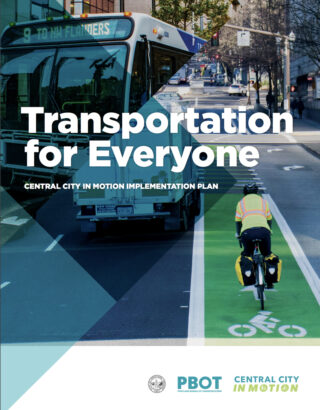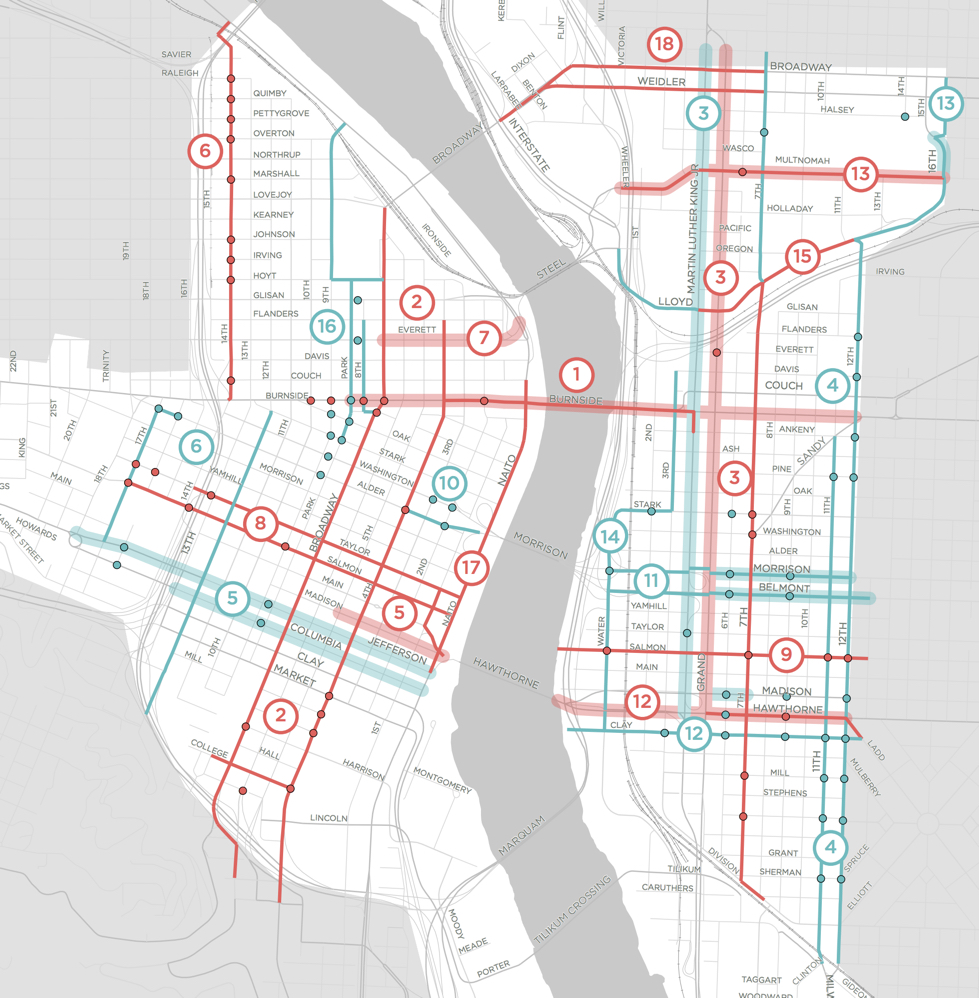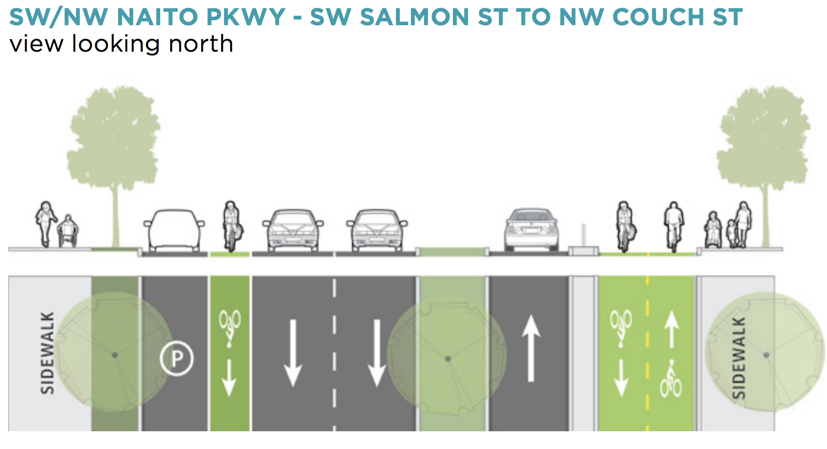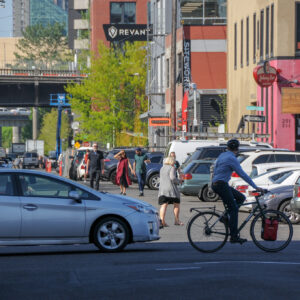
After many changes in the past few months, the ink is finally drying on the Central City in Motion plan.
This week the Portland Bureau of Transportation published a bunch of new documents (including the official Implementation Plan) and changed the council hearing date to this coming Thursday November 15th at 2:00 pm.
This is not a drill.
With two years of public outreach and planning all tied up in a bow, all that’s left is to make closing arguments, get this thing passed at City Council, and start building.
Here’s what made the final cut…
The Projects

The 18 projects (a.k.a. “super project bundles”) have been finalized and separated into two construction phases: 1-5 and 6-10 years (map above shows all of them). Since we last reported on this plan, three projects have been added back onto the list at the request of various organizations and agencies: the Grand Avenue transit/freight lane (at the request of the Central Eastside Industrial Council, Portland Streetcar, and TriMet); NW 14th protected bike lanes and safer crossings (at the request of the Pearl District Neighborhood Association); and NE Multnomah upgrades (at the request of Go Lloyd).
Below are the final recommendations for 1-5 year implementation. As you read the list, note the following: The number corresponds to official project number and is not a ranking of priority; “BAT” lane is short for Business Access and Transit; some projects listed are just small chunks of larger projects.
1 – Burnside (from W 10th to E 12th) – $5.5 million
The proposal includes a Bus and Turn lane, a series of crossing improvements, and protected bikeways. These investments will provide faster, more reliable TriMet service, improve safety and accessibility on West Burnside approaching the bridge, and facilitate more cycling trips across the river
2 – Broadway (from SW Grant to Broadway Bridge) 4th Avenue (from SW Caruthers to NW Flanders), and SW College – $6.6 million
This project would create a signature north-south bike facility on the 4th Avenue and Broadway couplet, while upgrading unsignalized pedestrian crossings in South Downtown. The couplet would increase access for people biking to major destinations and employers, including PSU and the downtown retail core, and increase crossing safety along both streets
3 – NE/SE 7th Avenue (from Sullivan’s Span to Division) and SE Grand Ave – $5.4 million
Coordinating to serve freight, auto, transit and bike needs, these projects would improve how people move through the heart of the Central Eastside. MLK and Grand would include Bus/Streetcar and Turn (BAT) lanes that could also accommodate freight. New pedestrian crossings of MLK and Grand would improve safety and access. Protected bike lanes on 7th Avenue would connect the Sullivan’s Crossing to the Tilikum Bridge. 6th Avenue, the likely location of the future Green Loop, would include new pedestrian crossings.
5 – SW Madison (from SW 5th to SW 1st) – $170,000
Moving the bike lane on Madison will eliminate weaving with the buses. Portions of the bikeway connections from the Hawthorne Bridge will be protected. Separating people biking on Madison from other vehicles will improve safety for all roadway users. To accommodate the BAT lane from 1st to 5th Avenues on SW Madison, all parking would be removed.
Advertisement
6 – NW 14th (from Burnside to Front) – $530,000
NW 14th would create a protected bike lane from Burnside to Hoyt, and a wide bike lane from Hoyt to Savier. To accommodate the protected bike lane on SW 14th Avenue from Burnside to Hoyt, parking on both sides of the street
would be removed from Couch to Everett and one travel lane would be removed from Everett to Glisan.
7 – NW Everett (from Broadway to Steel Bridge) – $1 million
This project would make bus trips faster and more reliable by adding a Bus and Turn (BAT) lane on Everett approaching the bridge. It would address the ramps on the west side of the bridge that create merging conflicts, further improving transit commutes out of downtown. To accommodate a BAT lane on NW Everett from Broadway to 2nd Avenue, a travel lane would be removed.
8 – SW Salmon/SW Taylor/SW 1st – $3.9 million
… creating a protected bike lane on Salmon/Taylor. They would link to the Hawthorne Bridge via a new protected bike lane on SW 1st. Pedestrian crossing improvements on both streets and bus stop improvements on SW Salmon are also proposed. To accommodate protected bike lanes, parking would be removed along one side of Salmon and Taylor.
9 – SE Salmon – $490,000
SE Salmon community greenway would provide a family-friendly bike connection to the Eastbank Esplanade and the Willamette River. This project would include improved crossings at the intersections at Water, MLK, Grand, 7th, 11th, and 12th.
12 – SE Hawthorne (from viaduct to 12th) – $1.2 million
… transit priority at intersections on Hawthorne and Madison, protected bike lanes on Hawthorne. New transit islands on Hawthorne would increase transit speed and reliability while reducing conflicts with people driving and biking. To accommodate a parking protected bike lane, the northernmost lane on Hawthorne would become a pro-time parking lane; no parking would be provided on the north side of Hawthorne during the peak hour.
13 – NE Multnomah – $3.8 million
This project would improve the existing parking protected bike lane on NE Multnomah and address bus/bike conflicts (by building transit islands). A Neighborhood Greenway on NE 16th would provide a connection between this route and NE Portland neighborhoods. On NE Multnomah Street, the current buffered bike lane would become a parking-protected bike lane.
15 – NE Lloyd (from MLK to 12th) – $740,000
This two-way bikeway along Lloyd would provide a cycling connection from the Steel Bridge to 16th. It would connect to the forthcoming Sullivan’s Crossing – a new pedestrian and bicycle bridge to be constructed over I-84 at 7th Avenue. To accommodate the protected bikeway from Grand to NE 9th, one travel lane in each direction would be removed. To accommodate buffered bike lanes from NE 9th to NE 12th, the center turn lane would be removed.
16 – Pedestrian crossings of Burnside – $870,000
17 – Naito Parkway – $4 million*

This project would implement a year-round version of “Better Naito,” providing a two-way cycletrack and sidewalk along the west side of Waterfront Park. Modern signal equipment would be installed along the corridor to better coordinate signal timing. Smart signals will smooth auto access to I-5 by detecting vehicle queues waiting to turn onto the Morrison Bridge. To accommodate the two-way cycletrack, one north bound travel lane will be removed. PBOT studied moving the bikeway into Waterfront Park, but determined the tree impacts were too great
*Notice PBOT has decided against a version of the project floated by Mayor Wheeler (and championed by the Portland Business Alliance) that would have maintained existing auto capacity between Salmon and the Morrison Bridge. PBOT has also (very smartly) laid to rest the idea of making a bike pathway through Waterfront Park (another idea pushed by the PBA).
18 – NE Broadway/Weidler (phase I) – $1.5 million
This project would reconfigure travel lanes where feasible to create protected or buffered bike lanes for improved safety and circulation. The project would extend from the Broadway Bridge to NE 7th Ave to connect with existing bike lanes in the Lloyd neighborhood.
Is it starting to sink in yet? This is stuff PBOT will start building next spring. Here’s how they’ll pay for it…
The Funding
This first tranche of projects is estimated to cost about $36 million (total cost of all projects in the plan is twice that). Lest you think this is a repeat of the 2030 Bicycle Master Plan which had no dedicated funding, PBOT says they have about $25 million in their pocket, ready to spend. It comes from a combination of a federal grant, assistance from TriMet, and fees paid to PBOT by developers.
The city is still $9 million short for this first phase and would still need another $36 million for the 6-10 year projects.
Keep in mind, that all this stuff is fluid and PBOT is likely to find more money and even switch projects around from the two phases. PBOT is a pragmatic and opportunistic agency and while they need a certain amount of specificity to pass the plan at City Council, by no means is all this stuff set is stone.
In these final days before the hearing, PBOT and their advocacy partners are prepping presentations and testimony. Check out the plan on PBOT’s website and stay tuned for more updates and coverage early next week.
— Jonathan Maus: (503) 706-8804, @jonathan_maus on Twitter and jonathan@bikeportland.org
Never miss a story. Sign-up for the daily BP Headlines email.
BikePortland needs your support.






Thanks for reading.
BikePortland has served this community with independent community journalism since 2005. We rely on subscriptions from readers like you to survive. Your financial support is vital in keeping this valuable resource alive and well.
Please subscribe today to strengthen and expand our work.
Looks like they reinstated the NW portion of project 2 that connects it to the Broadway bridge! That makes me very happy, without that section project 2 felt more like a bike lane to nowhere.
PLEASE COME TO THIS. This will be the first big test of bicycling in front of city council in a long time. Last time they had to make a choice this big was bike master plan. We must show that bicycling has the support of Portland. How this vote goes down will have big impacts on future projects and how big PBOT has the confidence to go to do the big hard changes we all know are needed.
***Hi Commenter (I know “soran” isn’t your real name, nice try though!),
You’ve been blacklisted. Nothing you write will show up unless you stop using fake names and making mean and unproductive comments. Thanks.
— Jonathan, publisher & editor***
I had been wondering why some comments disappeared after I refreshed the page, as well as why some comments seemed a bit more aggressive than I was used to seeing from names I recognized…
WHAT HE SAID. The Street Trust, Bike Loud, Bus Lane Project, Business for Better Portland, Portlanders for Parking Reform, Better Blocks are coordinating our efforts. If you’d like a copy of our talking points, please contact me at The Street Trust. Wear something “high viz.” If you don’t want to testify, just being there is a help. We’ll have signs for you.
Why..when outer NE/N/SE are lacking so much..
It’s called “equity”. First you build a world-class system for rich people and tourists around downtown and then it will eventually trickle down to the poor and lower-income people who live on the periphery of the city and constitute a majority of Portland’s residents and taxpayers.
Remember the Golden Rule: Those with the gold, rule.
There’s high density of affordable housing and people in need of social services within the central city. It’s not a one or the other situation. We need to do both, and I hope people will testify as such. Also, many people who work downtown but live further out due to prices don’t use alternatives because they’re not prioritized. This is a major step in the right direction.
They don’t use alternatives because they don’t exist and because the city simply keeps refusing to build what’s already been funded for the past 8 years. 37% of the city lives east of 82nd, and another 20% on the northern periphery, the poorest of the poor, so yes, it is in fact a case of one versus the other, I’m afraid. Does downtown have huge homeless camps like they do in the outer parts? Is it car-dependent like the outer parts because people have no other choices?
You understand that there has been, and will continue to be investments in East Portland? To the tune of millions already, and there’s a lot more in the pipeline. It’s just not glaringly obvious because East Portland is so shockingly behind the rest of the city, and PBOT doesn’t seem to have the necessary sense of urgency out there. And of course I would love the city to get more ambitious with timelines, but that doesn’t mean we shouldn’t invest in the central city with money that has been earmarked for CCIM for years now, and it’s where many of those East Portland folks work or pursue health and social services downtown. Again, this is NOT a one or the other situation.
According to the City of Portland Bureau of Planning and Sustainability, no more than 15% of East portland workers work downtown; most work along the Columbia Corridor or Swan Island in manufacturing, with most of the rest in Gresham, Clackamas, or in Clark County. Moreover, East portland already has a large hospital (Adventist). In addition, on top of the already unfair property tax structure in Oregon that sees East portlands paying more than their share, East portlanders have to drive to downtown (since they do lack basic infrastructure for other modes) and have to pay for their parking irregardless of their income, further supporting downtown development at the cost of further inequity to the city’s poorest residents.
If it costs more to live out there, why do people choose to live there?
Glenn F., you might be interested in this passage from the CCIM Implementation Plan:
Has there been any construction at all? Any thing like $255 million would entail? How about a modest 10%, $25 million, for this past year?
of course there has been construction.
I’m not going to argue this with you right now David. I personally think it’s an unproductive road to go down and I think it would be a loss for Portland if we saw the CCIM lose support because of the east-Portland-versus-everyone-else debate.
I’m impressed YOU think it East portland versus the rest of the city, this is a form of progress, I suppose. But in reality, according to the city’s own budget mapping, it’s the periphery versus the central city, with the central city getting the lion’s share of resources, while the 80% living in North, Southwest, Cully, B-D, and East not only get paltry resources, but huge delays even on the few resources that they do get. $255 million for East Portland? Most of that is ODOT funding for Powell Blvd. Since when did PBOT boast about ODOT? And since when did BP support ODOT’s efforts in East portland? Not in my lifetime.
Both the Se Uplift and NE Neighborhood Coalitions have endorsed CCIM.
The Board of SE Uplift “endorses the goals of the CCIM plan and that PBOT should build as many of the projects as quickly as possible.”
Where is number 4? I’m assuming protected bike facilities.
Absurdly, #4 comes in later years, 6-10, for facilities on SE 11th & 12th. Funny how that works…
Buffered bike lanes which probably had something to do with it getting low votes at open houses and being de-prioritized.
City is giving away a whole travel lane on Grand and MLK as dedicated to Freight as a last minute boon-doggle? Very limited details on this – would be fine if freight had to only use that lane, but we know freight will use any street in Portland to get their container to the rail yards faster. UPRR should be funding this.
More parking protected bike lanes with frequent chaotic intersections along SE 7th. These are really just scooter-bro lanes. Lime should be funding this.
This plan has some nice nods to bike travel, especially west of the river, but don’t be fooled, it’s for freight and transit, with just enough pro-scooter green paint to get you on board.
The City should be working with UP to relocate the Brooklyn yard out to a big plot of land between Canby and Aurora. Direct access to I-5, 99E, more space, etc. They can turn that area into housing and save the neighbors from harmful emissions.
Dedicating road space to freight is a bad idea. How is this enforced?
Super grateful to hear about #9 – SE Salmon crossings, @ $490k (relatively inexpensive it seems). These crossings have vexed me for many years. This is a major bikeway to & from the central city, yet these busy street crossings are oddly difficult & sketchy. Some other good news here too, but this one really stands out for me.
“SE Salmon community greenway would provide a family-friendly bike connection to the Eastbank Esplanade and the Willamette River. This project would include improved crossings at the intersections at Water, MLK, Grand, 7th, 11th, and 12th.”
I can’t speak for all of East Portland but I can speak from my personal experience. This area was the one of two areas where I could afford to buy a property within my income earnings five years ago. The other was outer SW Portland. Even St. John’s was too expensive. Only the “crescent” of East Portland dipping into Cully and Brentwood-Darlington and the remote areas of SW Portland were even an option. That’s the why for people living in East Portland -simple market economics. The reality as David alludes to though is the historic lack of investment from the local governments has resulted in residents of East Portland paying more tax for less services (i.e. roads, sidewalks, etc.).
Long, long overdue. So excited to see this happen and open downtown to low stress trips.
I used to go downtown with my family to shop, eat, and walk. But the lack of car control and rampant abuse of SOV trips has made it too stressful to travel there by car, transit or bike.